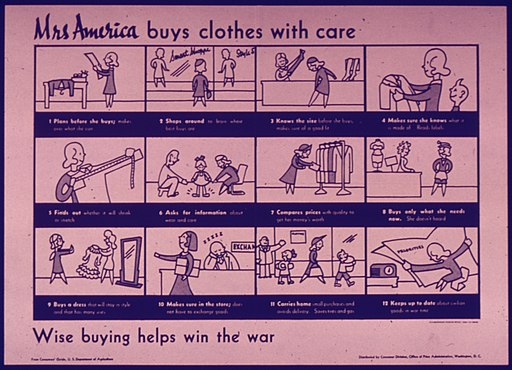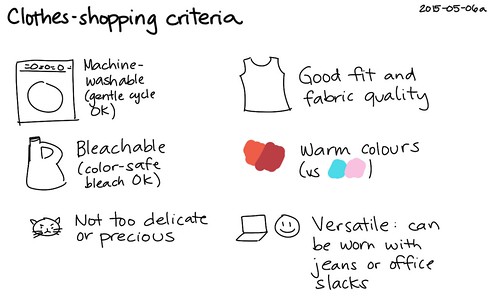Having a clothing budget is more useful than I’d realized. It doesn’t just keep your spending in check, it helps you spend more wisely, too. Not solely because your spending is limited, but because keeping records of your incomings and outgoings allows you to look back and see which buys turned out to be the good ones, and which didn’t.

I’ve had a clothing budget for just over three years now – $25 a month ($18 US), which covers pretty much everything but shoes. Each month I keep a record of what I spent, and – most importantly – on what. Brace yourself: things are about to get statistical.
In the three years I looked at, I spent $860 on clothes. (That’s about $625 US.) Which, frankly, seems like a massive amount! I made a list of each item I bought over the three years (divided by year), what I paid for it, whether it was new or second-hand, and whether I still wear the item or not – and if not, why.
I spent $40 on clothes which I am already no longer wearing. Actually, there’s another dress I’ve only worn once, but it’s a special occasion dress, so the verdict is still out on whether I’m avoiding it or just haven’t had many suitable occasions yet. If it turns out I am avoiding it, that’s $60 total I’m not wearing any more.
Most common reasons for not wearing something any more? It doesn’t fit, or it doesn’t suit. That seems reasonable. Then I looked at the breakdown of new versus second-hand. It turns out that fully half of the second-hand items I bought in those three years I no longer wear (five of ten). But I’m still wearing 13 of the 15 new items I bought.
Why? My guess is that I’m a lot less picky when it comes to second-hand clothing, because it’s so much cheaper. But if I’m going to spend good money on something, it better be worth it! The decision-making process increases in length proportional to the price of the item.
In support of this theory, I note that the two new items I’m not wearing any more were a super-cheap t-shirt (this was before I started shopping ethically) and a zip for a second-hand skirt. Total cost, $6.60. In fact, the average price of the garments I’m not wearing any more is less than $7. Shocking.

Where things really got interesting was when I started comparing how many items I bought in each year, and how much I spent on average per item. Remember, it’s just this last year I’ve been making an effort to shop ethically.
In 2015 I bought 11 items at an average of about $28 each. (Buying a swimsuit pushed the average much higher than it would otherwise have been.)
In 2016 I was still in the red from the expenditures of the previous year, so I only bought six items – average about $38.
In 2017 I started shopping ethically, and here’s where you’d expect the prices to skyrocket, right? I bought eight items, for an average of about $40.
Overall, I did spend more in 2017 than in the preceding years, but that was still less than $20 over what I spent in 2015.
To be honest, the real cost to me in shopping more ethically hasn’t been the financial cost. It’s been the cost of planning, the cost of avoiding the easy buy and taking the time to find ethical options.

Side note: if anyone’s interested in encouraging the ethical shopping habits of Australasians, what would be really helpful is a guide to what can be bought where. Don’t just tell me XYZ has an A rating, tell me where’s good for buying pajamas, or socks, or collared shirts…
So those are the lessons my clothing budget has taught me so far: it’s worth taking the time to be sure about an item before buying it – no “close enough is good enough” buys; and shopping ethically isn’t that much more expensive.
Will I keep on with this? You bet! For one thing, in the next few years I’ll be getting some valuable data on how long various garments last. Because no matter how much I expect my clothes to be immune to the ravages of time, nothing lasts forever.








